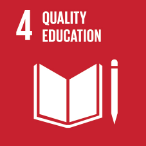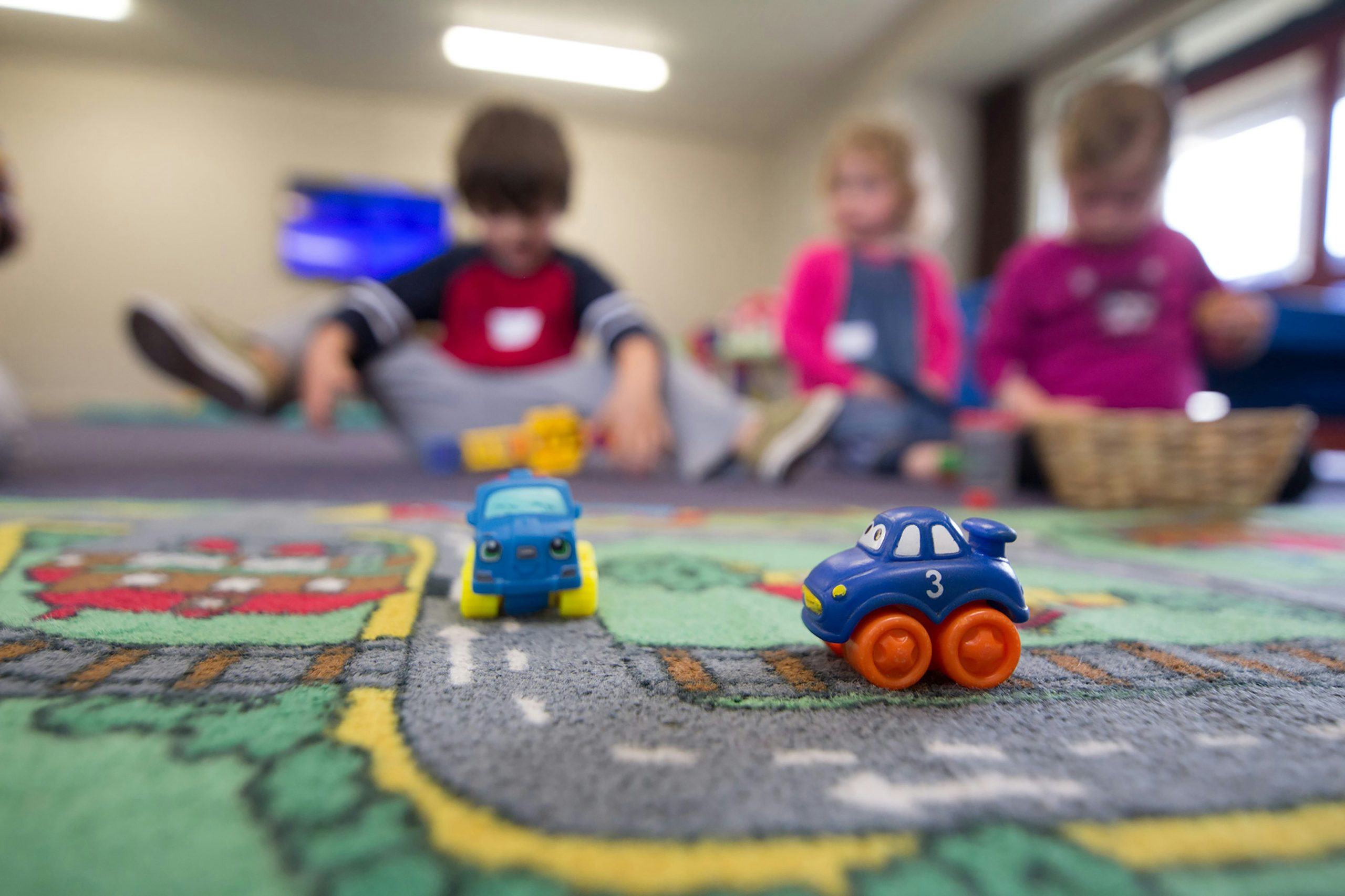SDG4 – Quality Education

New Vocabulary
- numeracy
- literacy
- secondary school
- post-secondary education
- technical
- vocational
- tertiary
- equitable
Practice the new vocabulary
Quality Education Vocabulary (text version)
Match the words to their definitions.
Words:
- tertiary education
- post-secondary education
- numeracy
- equitable
- literacy
- secondary school
- technical education
- vocational education
Definitions:
- the ability to do calculations and understand simple mathematics
- the state of being able to read and write
- high school
- college, university, or any higher educational institution
- the academic preparation for jobs involving applied science and modern technology
- lessons that prepare people for a skilled trade or craft such as carpentry or hairdressing
- the same as post-secondary education
- treating all people in a fair and equal way
Check your answers in footnote[1]
Activity source: Quality Education Vocabulary by Virginia McHardy, CC BY-NC 4.0
Quality Education
According to the United Nations Department of Economic and Social Affairs (n.d.) Goal 4 Infographic:
Perhaps being one of the most important SDG 4, Quality Education should be a right for every single person on this planet. It is a goal that is needed to help all other SDGs. Quality Education also means opportunities for lifelong learning. However, education progress is too slow. If we don’t meet our goal in 2030, 300 million students will lack basic numeracy and literacy skills.
- In 2019, only 58% of students worldwide were literate by the end of primary school.
- Many countries are falling behind in middle school learning levels because of the COVID-19 pandemic.
- Secondary school graduation rates are improving slowly since 2015.
- In some regions, like sub-Saharan Africa, there are not enough teachers, too many students per teacher, and poor teacher training.
Focusing on improving education (SDG 4) will help achieve all the 2030 goals.
Canadian Perspective
Goal 4, Quality Education (text version)
Ensuring inclusive and equitable quality education and promoting lifelong learning opportunities for all
Tertiary education[2] attainment
In 2021, Canada’s average tertiary education attainment rate[3] was 62%.
| Characteristic | Attainment rate |
|---|---|
| Females aged 25 to 34 | 75% |
| Males aged 25 to 34 | 58% |
More than 4 out of 10 Indigenous persons aged 25 to 64 living off reserve attained tertiary education.
Equitable access to quality education
In 2022/2023, the average annual tuition fees for undergraduate programs in Canada are $6,834. Average tuition fees are almost three times higher in Nova Scotia than in Quebec.
| Geography | Average tuition fees |
|---|---|
| Nova Scotia | $9,328 |
| Saskatchewan | $8,854 |
| New Brunswick | $8,284 |
| Ontario | $7,920 |
| Alberta | $7,221 |
| Prince Edward Island | $7,082 |
| British Columbia | $6,256 |
| Manitoba | $5,251 |
| Yukon | $4,200 |
| Newfoundland and Labrador | $3,400 |
| Quebec | $3,359 |
| Northwest Territories | Note …: not applicable |
| Nunavut | Note …: not applicable |
| … not applicable | |
Equitable access to non-parental child care in 2022
Among parents who had difficulties finding child care[4], over half had difficulties finding an arrangement in their community.
Top 3 impacts on parents and families who have difficulties finding child care
- Having to change their work schedule
- Working fewer hours
- Paying more than desired
Community spotlight: Digital Moment
Digital Moment provides digital education to youth, with a focus on girls and under-served communities.
Digital Moment has reached 630,000 youth since September 2017 and expects to reach 1 million by 2030.
Sources: Statistics Canada, Labour Force Survey, 2021, Tuition and Living Accommodation Costs, 2022/2023, Survey on Early Learning and Child Care Arrangements, 2022; Digital Moment.
Source: Goal 4, Quality Education In Agenda 2030 Sustainable Development Goals Report, 2022 by Statistics Canada, used under Open License
Discussion Questions
Use the new vocabulary words in these discussion questions. Ask and answer in partners or small groups:
- Why are literacy and numeracy important skills for everyone?
- What can governments do to improve literacy and numeracy rates in schools?
- What challenges do students face in completing secondary school in your country?
- How can students decide between post-secondary options like university, college, or technical schools?
- Why are technical and vocational schools important for a country’s development?
- Do you think tertiary education should be free for everyone? Why or why not?
- What does it mean for education to be “equitable“?
- How can countries make education more equitable for all students?
Watch the video:
Watch Goal 4 – Quality education (2 mins) on YouTube
Video source: UNStats. (2022, July 7). Goal 4 – Quality education [Video]. YouTube. https://www.youtube.com/watch?v=1agRuNIytSg
Quality Education Video quiz (text version)
- What percentage of classes did millions of children miss because of the pandemic during 2020-2021?
- 47%
- 50%
- 14%
- True or false? Because so many children missed classes during COVID, about 24 million will go back to finish the months they missed.
- Match the words to the correct blanks: Over [Blank a] of primary schools worldwide didn’t have enough [Blank b], water, or basic [Blank c] between 2019 and 2020. Moreover, [Blank d]% didn’t have access to the [BLANK E] or computers.
- True or false? For children in traumatic situations, education is a salvation.
- In 2022, what was offered to 3 million Ukrainian children during the war?
- In-person classes
- Learning in the countryside
- Learning online
Check your answers in footnote[5]
Activity source: Quality Education Video Quiz by Virginia McHardy, CC BY-NC 4.0
Key Targets for SDG 4
- 4.1 By 2030, ensure that all girls and boys complete free, equitable and quality primary and secondary education leading to relevant and effective learning outcomes.
- 4.2 By 2030, ensure that all girls and boys have access to quality early childhood development, care and pre-primary education so that they are ready for primary education.
-
4.3 By 2030, ensure equal access for all women and men to affordable and quality technical, vocational and tertiary education, including university.
-
4.4 By 2030, substantially increase the number of youth and adults who have relevant skills, including technical and vocational skills, for employment, decent jobs and entrepreneurship.
-
4.5 By 2030, eliminate gender disparities in education and ensure equal access to all levels of education and vocational training for the vulnerable, including persons with disabilities, indigenous peoples and children in vulnerable situations.
-
4.6 By 2030, ensure that all youth and a substantial proportion of adults, both men and women, achieve literacy and numeracy.
-
4.7 By 2030, ensure that all learners acquire the knowledge and skills needed to promote sustainable development, including, among others, through education for sustainable development and sustainable lifestyles, human rights, gender equality, promotion of a culture of peace and non-violence, global citizenship and appreciation of cultural diversity and of culture’s contribution to sustainable development.
Source: United Nations Department of Economic and Social Affairs. (n.d.). Goal 4 [Infographic]. Sustainable Development Goals. https://sdgs.un.org/goals/goal4

Homework/Assignment:
Choose one country and research its education system. Create a short presentation or poster about:
- Literacy and numeracy rates.
- School challenges (e.g., lack of teachers or resources).
- Efforts to improve education.
You can read more about Goal #4 in The Sustainable Development Goals Report 2022 from the UN.:
For instructors, please visit York University’s The SDGs-in-the-Classroom Toolkit for lesson ideas
References
United Nations Department of Economic and Social Affairs. (n.d.). Goal 4 [Infographic]. Sustainable Development Goals. https://sdgs.un.org/goals/goal4
- 1. numeracy, 2. literacy, 3. secondary school, 4. post-secondary education, 5. technical education, 6. vocational education, 7. tertiary education, 8. equitable ↵
- Tertiary education is defined as all formal post-secondary education programs that are two years or longer. In Canada, it typically refers to education delivered in colleges and universities. ↵
- Attainment rate refers to the educational attainment of the population aged 25 to 64. ↵
- Child care is defined as any care provided to children by someone other than the parent or guardian, including formal and informal arrangements, licensed and unlicensed arrangements, full-time and part-time arrangements as well as paid and unpaid arrangements. ↵
- 1. b, 2. false, 3. Blank a - 25%, Blank b - electricity, Blank c - sanitation, Blank d - 50, Blank e - internet. 4. True, 5. c. ↵
the ability to do calculations and understand simple mathematics
the state of being able to read and write
the state of being able to read and write
high school
college, university, or any higher educational institution
the academic preparation for jobs involving applied science and modern technology
lessons that prepare people for a skilled trade or craft such as carpentry or hairdressing
the same as post-secondary education
treating all people in a fair and equal way

